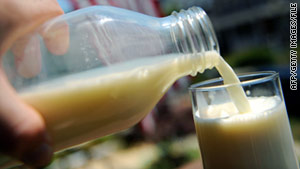Radiation in Seawater Off Japan Plant at All-Time Highs
A utility official says contamination came from a leak or ground seepage

Officials say there is no clear sense of what's causing the
radiation spike or how to stop it. (Getty Images / March 31, 2011) |
CNN
4:01 a.m. PDT, March 31, 2011
TOKYO, Japan -- The levels of radiation in ocean waters off Japan's embattled Fukushima Daiichi plant continue to skyrocket, the nation's nuclear safety agency said Thursday, with no clear sense of what's causing the spike or how to stop it.
The amount of radioactive iodine-131 isotope in the samples, taken Wednesday some 330 meters (361 yards) into the Pacific Ocean, has surged to 4,385 times above the regulatory limit. This tops the previous day's reading of 3,355 times above the standard -- and an exponential spike over the 104-times increase measured just last Friday.
Officials have downplayed the potential perils posed by this isotope, since it loses half of its radiation every eight days.
Yet amounts of the cesium-137 isotope -- which, by comparison, has a 30-year "half life" -- have also soared, with a Wednesday afternoon sample showing levels 527 times the standard.
"That's the one I am worried about," said Michael Friedlander, a U.S.-based nuclear engineer, explaining cesium might linger much longer in the ecosystem. "Plankton absorbs the cesium, the fish eat the plankton, the bigger fish eat smaller fish -- so every step you go up the food chain, the concentration of cesium gets higher.
On Thursday, Hidehiko Nishiyama, a Japanese nuclear safety official, reiterated that seawater radiation doesn't yet pose a health risk to humans eating seafood.
Fishing is not allowed within 20 kilometers (12 miles) of the plant, and he claimed that waterborne radiation should dilute over time.
Still, authorities don't know where the highly radioactive water is coming from or how it reached the sea.
The contamination may be coming from either a leak or ground seepage. The high levels suggest the release of radiation into the atmosphere alone couldn't be the lone source, an official with the nuclear facility's owner Tokyo Electric Power Company said Thursday.
Tokyo Electric has announced plans to spray a water and synthetic resin mix around the complex to envelop radioactive particles, so they can't spread any further. Still, persistent rain and wind forces authorities to postpone the start of that effort Thursday.
The Japanese utility and the government have gotten new help from beyond its borders.
Gen. Ryoichi Oriki, chief of staff for Japan's Self-Defense Force, said Thursday about 140 U.S. military members will arrive soon. The soldiers specialize in detecting, medically treating and decontaminating radioactive material.
A French nuclear group, Areva, has sent five specialists who are experts in treating contaminated water, the group said Wednesday.
And the U.S. Department of Energy deployed about 40 people and more than 17,000 pounds of equipment to Japan to help with the crisis, said Peter Lyons, the department's acting assistant secretary for nuclear energy.
The nuclear plant has been in a state of perpetual crisis since being rocked by the March 11 earthquake and subsequent tsunami, and there's no clear end in sight.
This has all left the plant's owner reeling, with the ordeal taking a significant toll on both its reputation and bottom line.
On Wednesday -- the same day the company announced that its president, Masataka Shimizu, had been hospitalized due to "fatigue and stress" -- Tokyo Electric's chairman Tsunehisa Katsumata said it had no choice but to decommission four of the plant's six reactors.
He acknowledged reports that Japan's government is mulling nationalizing the company after the disaster, saying, "We want to make every effort to stay a private company."
Beyond the recovery and clean-up expenses, Tokyo Electric will likely be asked to pay those who suffered because of the nuclear crisis.
A report from Bank of America Merrill Lynch estimates the utility firm will face 1 trillion Japanese yen ($12.13 billion) in compensation claims if the recovery effort lasts two months, rising to 10 trillion yen if it goes on for two years, said Takayuki Inoue, a spokesman with the financial giant.
That might include farmers, their livelihoods shattered after the detection of high radiation in several vegetables prompting the government to ban sales. Contaminated tap water also has prompted officials to tell residents in some locales to only offer bottled water to infants. Businesses have been hit hard, too, by rolling blackouts tied to the strained power grid.
But those most affected have been the thousands, living within 20 kilometers (12 miles) of the stricken plant, who have been ordered to evacuate.
The International Atomic Energy Agency on Thursday urged Japanese authorities to "carefully assess the situation" -- and consider expanding the evacuation zone further -- after high radiation levels were found in Iitate, a town of 7,000 residents 40 kilometers northwest of the nuclear facility.
The U.N. agency did not say how much radiation it had detected, though the environmental group Greenpeace said Sunday it found levels more than 50 times above normal.
Koboyashi Takashi, Iitate's manager for general affairs, said radiation levels in soil and water were decreasing. Residents had temporarily evacuated, but later returned to take care of livestock, he said.
Another village official, who declined to be named, was irked Thursday after the earlier radiation readings surpassed the IAEA's evacuation criteria but not those of the Japanese government. He said local officials have urged tests on soil from 70 locations around the village.
"We (have to) believe what the government tells us," said the Iitate village official in apparent frustration. "There is no other way."
Japanese Chief Cabinet Secretary Yukio Edano told reporters Thursday the "IAEA results will be taken into consideration," but said "there is no plan" to expand the evacuation zone to 30 kilometers or beyond.
"There is no immediate health hazard," Edano said, adding later that the government may offer free medical check-ups to those near the plant. "If the exposure continues for a long period of time, (a negative) impact can occur. We will continue to survey the situation."
Meanwhile, Japan's deputy finance minister said Thursday that this month's catastrophic quake and tsunami could cost the government in excess of 25 trillion yen ($300 billion).
As of Thursday afternoon, more than 11,400 were confirmed dead from the March 11 earthquake and subsequent tsunami, the National Police Agency said.






![[Bigbuy1]](http://si.wsj.net/public/resources/images/NA-BK877_Bigbuy_G_20110330182237.jpg)
![[SB10001424052748703806304576233233516830312]](http://s.wsj.net/public/resources/images/OB-NH853_BIGBUY_D_20110330182253.jpg)





